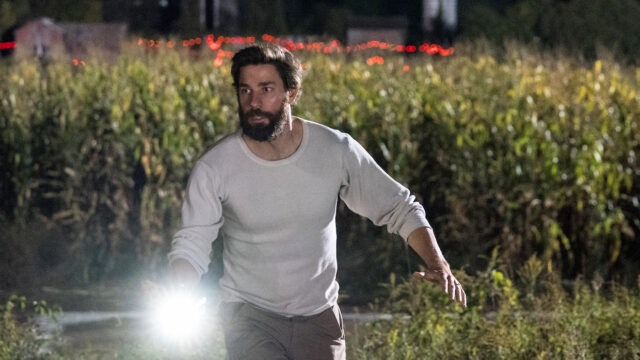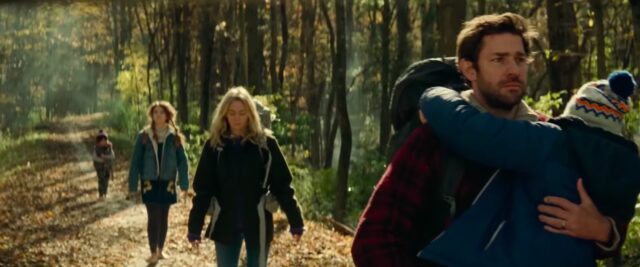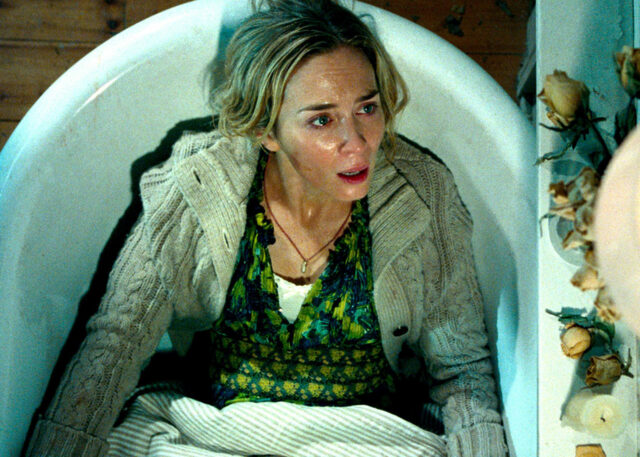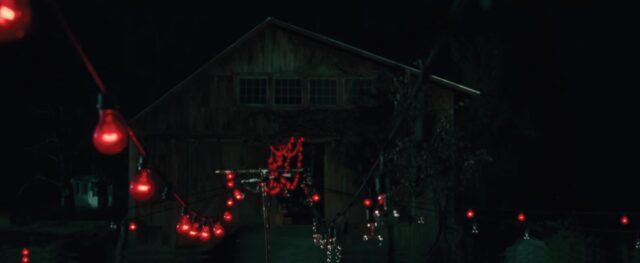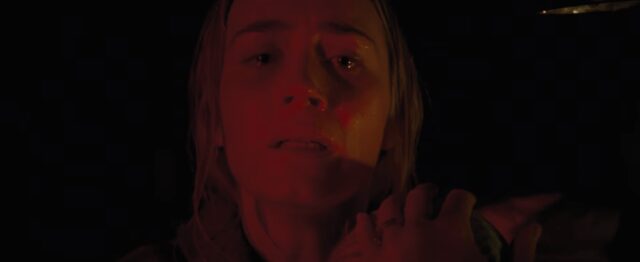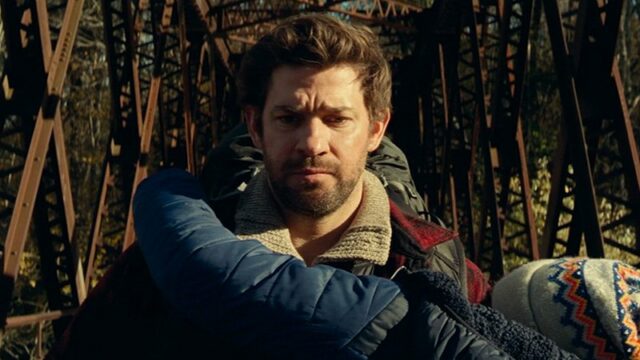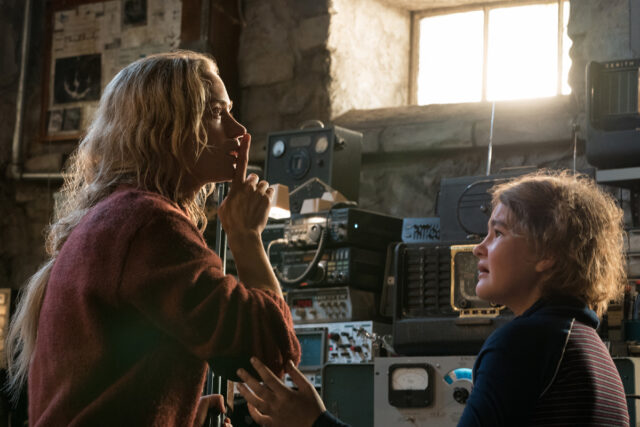“A Quiet Place” Cinematographer Charlotte Bruus Christensen Interview
“A Quiet Place” is a 2018 feature film by John Krasinski, starring Emily Blunt and John Krasinski, the movie is set in a post-apocalyptic future where making any sound can cause in your imminent death. It was lensed by Danish cinematographer Charlotte Bruus Christensen and shot on 35mm film, and I had the honor of talking to her about her process on a Skype interview.
Charlotte Bruus Christensen was very generous with her time to give us this Skype interview – and here’s the full transcript.
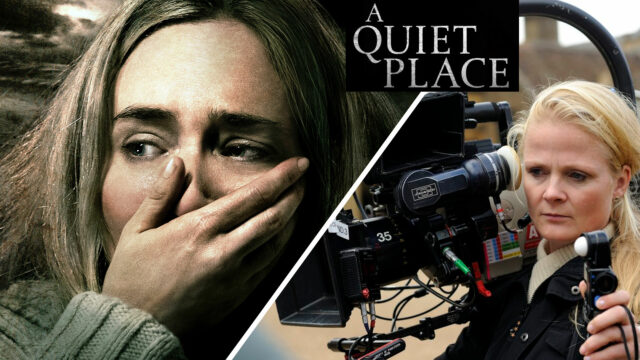
Director of Photography Charlotte Bruus Christensen (on the right) on the set of “A Quiet Place”, starring Emily Blunt. (Image taken from IMDb)
cinema5D: I actually just re-watched A Quiet Place a couple of days ago as preparation for this interview, and I have to say it really holds up as a great piece of film, a great film and a great piece of cinematography, even after the third viewing. Well, it definitely left a huge impact on a large audience, I think it did really well at the box office as well. Is this something you expected when you were working on this?
Charlotte Bruus Christensen: No, I think we were all… I mean, John Krasinski, the director, was always very excited about their idea and we all were. But it kind of really processed as a, not a smaller movie, but… but you know… an art piece almost. So I don’t think it was ever made, you know that we any of us thought there was gonna earn that much money and sell that many tickets. But obviously, the producers did and they did well in thinking that, you know.
cinema5D: Well, it feels like when you watch the movie, not only because of the remoteness of the film setting, but it certainly feels like as if it was a small crew working on this, as a very small independent film that of course has big names attached to it. Was it really like that?
CBC: It was in many ways, there was a simplicity to the way we made it, that made it feel like an independent and smaller movie. Yet, it was still a studio movie. You know, Paramount Pictures were behind it. But what made it kind of feel small was that John and the location team found this amazing location upstate New York, so everything is shot in this location. There’s a couple of sets that are an hour or two north of there. But it meant that the crew was traveling up there and we settled down, it wasn’t a huge crew, there were four people in the main cast and a couple of other names on there, but it’s a small cast. So, it just made it feel small, we didn’t have a big stage to do the few sets that we had on the stage, and there was a nearby riding arena. So, we just built those three sets in this riding arena. So, it made it kind of feel very independent, like a small family that was just really excited about this project and this idea. It’s a high-concept project. John Krasinski, he’s a man full of energy and it kind of gives something to everybody, the people behind it really believes in it. So, it felt like an independent movie.
cinema5D: So, how did you initially get involved with the project? I know that you met Emily or became friends with Emily Blunt on the set of ‘The Girl on the Train’, is that right?
CBC: Yes, we met on that movie and that was a really close relationship and I am just really fond of her, she’s an amazing actress and a good friend as well. So, she called me, I remember it was summer and I was back home in Denmark and she sent a text “are you home? My husband, John Krasinski, has found a script he wants to rewrite and I just think you two should chat and I sent him your number”. And I put down the phone and John called, literally, 30 minutes later or something and he did the first pitch, which was a year before we started shooting the movie. So, yeah the project came by through Emily and it was her idea to put us together.
cinema5D: Great, and it came into a real project quite quickly, is that right? you only had 30 shooting days when you were actually starting to shoot, right?
CBC: Yeah, it took about a year to get everything in place, so we shot the following summer. But yes, once we got the project and the budget and the locations, all that in place, we only had 30 shooting days, so it was a fast shoot. It was a $17 million budget, and, obviously, some of that had to go to the VFX and there was a character, a creature that had to be built so, some of the money had to go do that. So, it was a very tight schedule, which was probably the biggest challenge of this entire shoot, You know, it takes place over two days, the opening is quite a few days before, but then, once we get into the movie, it’s over two days. So, to try and make this work, the continuity of the light in the night and all that was a challenge.
cinema5D: I guess the limitation also is a benefit, because, in many horror films, you probably were limited in the amount of visual effects shots you could do because of the budget.
CBC: Yeah we had like 50 shots or something, so we sat down, John and I and the producers and we’re like: “well, in this one we want to see the creature”. I think we ended up with a few more than that. But everything was tight.
cinema5D: A Quiet Place is really an unusual kind of film, also because of the fact that it’s indeed very quiet because of the necessity of the characters to make no noises in order to survive. I wondered, because of that sensory deprivation, in the audio department, that also automatically means that the audience focuses more of its attention on the visuals. So it automatically becomes a more visual film than your average movie, I think. After reading the script for the first time, how did you go about actually planning the look of the film together with John Krasinski?
CBC: He had a clear overall vision for the movie, which was… …he always thought about it from the very beginning as a very cinematic piece a piece that needed to really taking the landscapes. He showed me some a couple of reference movies, which were big movies like No Country for Old Men and There Will be Blood, and Jaws. So we look at those films, and it’s not that they were direct references but there was something about these movies, they felt like they have a certain confidence. And so we took that work and said, well, off these movies what we needed to learn and look into is how do we create that confidence. It seems solid. So, there was that kind of confidence works that we really wanted to try and explore. On top of that he gave me a few things, like this family portrait, we wanted to kind of give that a very poetic approach, which was interesting to match that poetic approach with the horror creature elements. So, there was some mix between genres and that obviously gave me a lot to work with alongside the whole concept of the movie, where there’s very little dialogue and the cast communicate with sign language, so that was another element that I needed to really consider, and think about how to make that work.
cinema5D: One of the first things I thought when I watched the first scenes of the film for the first time was, you realize that something is going on with sound, people are not allowed to be loud, and as a cinematographer myself I thought “how interesting”, because that of course influences what kind of lenses you choose, your framing, how far you can be away or have to be away from your subject matter. How did all of that go into consideration when actually planning it? And did you storyboard the film?
CBC: We didn’t storyboard the film. There was a desire from producers in the studio to storyboard some of the creatures scenes, just to figure out how many shots for the budget and all that. But it never really worked for John to storyboard these things. He wanted to approach it with a more free… he wanted the freedom to just discover what is this character what is this creature gonna do in the scene when I start rehearsing it with Emily and the rest of the cast. So, it didn’t work for him to storyboard. So we did some but we never really used them. So, it was a very organic process. John, as everybody knows, is a great actor as well, and that’s what he’s been doing. He’s done a couple of movies before this, but he’s developed as an actor. And working with actors who are directing, they’re used to responding to things on the set, and I think that’s what we did. Obviously, we planned certain things, there are some shots that he had mind from writing the script. And those shots I would then build other shots around it, and we would talk about it I would offer it up and he would confirm it. So, it was a very organic process, which kind of worked very well for this, because we wanted to keep that poetic feel and that truthful atmosphere and that it was a true story, that this family really did… So, we didn’t want the horror approach with the more traditional low angles, wide angles for horror movies. There are a couple of them, but that wasn’t what we wanted to do. So, it was an organic process, not storyboards. Some days we had a couple shots lists, but not like “this is what we’re doing”, it was worked out on the set.
cinema5D: Did you find yourself being limited or challenged by the sound design? Because of course you always had to be close with the camera to the characters with wider lenses, in order to be able to hear them on screen.
CBC: I was definitely challenged by that, because it started another process for me, just realizing that the energy of the sound design really also depends on where do we place that lens. If we place the lens really close to somebody, there will always be a sound. Even though somebody’s trying to be quiet, if you’re close you’ll hear movements and clothes and feet in the sand, there would be a proper sound design. Whereas if you had that same size image but on a long lens further back, there would be a cut in the sound and no sound. So I was really challenged by just considering and imagining what the sound should do or could do in certain places and then placing the lens accordingly. So, on this one, more than any other movie I’ve done, that thing of being wider lens close or longer lens further back, was more important than some others. Where sometimes it’s more about being pretty or you wanna isolate the character but you can still have the sound close because that’s just what you do with movies. It was really important on this project.
cinema5D: With this film I feel like it has so many strong scenes, like, for example, the infamous bathtub scene can become movie history. Did you feel like that when you were shooting them? Did you feel like there is a potential to something bigger?
CBC: Yes and no. I don’t think I kind of thought this could be history, I don’t think I would dare to think things like that. But I do recall looking through the camera on shots like the top shot of the bathtub when Emily Blunt is lying and she does that scream, and then the light that’s flickering on one side, I do recall that we all stepped down from the camera, ran into the monitors, where John was and we all felt like that was special, that was something crazy. I remember Emily turned up that morning before that scene, and she said to me “get your shit together, and I’m not gonna do this three times, so don’t come and say that some light didn’t work, get your stuff together when you’re ready, we’re gonna do this, I’m not gonna keep screaming forever. So I knew it was kind of limited in terms of the number of times But anyway, I think we take one to just delivered that. And John and Emily being a couple, they discuss things closely beforehand. But I remember stepping down from the camera, I ran in and she came and was like “did that work?” were like “oh, yeah, it worked pretty well!”. We were all very excited, so we definitely knew that there was a special moment for us in our movie, but not that it would be something that people would recognize that one shot and then know that that is the movie, which I feel it is now, if you see that shot people know that’s ‘A Quiet Place’. That’s pretty cool.
cinema5D: You obviously decided to shoot on film, you’re no stranger to film of course, you shot many projects on film, I saw in your filmography. But why did you decide to shoot on film for this particular project? Because I think it’s probably, from a producer’s point of view with a movie that maybe 50% of which plays in darkness, it’s kind of a daring thing to do.
CBC: Oh yeah, and it did take some persuasion and explanation to try and persuade the producers to shoot on film. But I felt from the very beginning that the reference movies that John was showing me and things that he was saying, the things that I started developing and the view and the landscape that was around this barn and the anamorphic views and we wanted this family to really have a warm feel to it, that it’s all about love, that’s why they survive. So, the feel from the barn needed to be warm and all that. And then there was a lot of makeup, because people have been living for quite some time, not a lot of washing and not a lot of haircuts. So, the sunburned look was all makeup, and the dirt and all that. And just knowing that we had to do so many real close ups because of sound, I just thought all these factors, we speak our way around to shooting on 35mm. So, I discussed it with John and he was like “well, why?”, So I first of all sold it to him and he kind of bought into it and felt that that was a great idea and it was what he wanted, so, together we wrote a letter to the producers and explained why. It was a bit of a fight obviously, the budget and the numbers versus digital numbers and how much do we shoot and all that. But in the end I think knowing what the project became and the look at the movie, I think everybody’s really happy about that and it was true what we said, it goes directly for the look that we want, rather than be spending more time in DI creating it. But I love digital too, I don’t know why I end up on projects that just calls for 35m. And I do love it I, do love working with it, I love working with the light meter, I feel there’s a simplicity to it that I like. But it doesn’t mean that I don’t want to shoot things in digital. To me it’s just interesting with all the digital tools available, it still seems so hard to make something really look like film and you said that in another interview and I completely agree, I think there’s nothing like the blackness of film. there’s a specific kind of blackness in film which makes it look so real and organic and also scary. Because with digital you always know, you could brighten it up, you could see whatever is there. With film it’s somehow, that’s it, and it has a quality that’s hard to describe. But shooting shadows and blackness in digital, if you lift that it becomes grayish, If you lift film black it becomes grainy, which is more alive, not that you always want to lift it, if you choose to make something black it’s because it should be black, hopefully. But in any case, it’s just more alive, I don’t know what is the reason. And black was certainly a character in this movie because we have certain scenes where they go to this basement and it’s completely black, it’s not like film black. There’s one scene where he’s carrying her after he find her with the baby and he carries him into the basement. And we decided to make that black, they just walk through one little sliver of light. As you said, it just has a difference, it becomes alive, it just works well.
cinema5D: Is it difficult working with the director who’s also one of the main characters, especially when shooting on film? Because, obviously, you need to show him the video tab after the take. Usually, I know from my film school times shooting on film, that that video tab is often not of the greatest quality. I’m sure you had HD at least, but still, it’s different from seeing something on a pristine 4k monitor.
CBC: Yeah, it is, even with the HD tabs, it’s not a great image. So, I think it somehow helped John being an actor, knowing his performance, doing it, obviously he wanted to go and see it and wanted to see it in the environment and lighting and all the rest of it, but I think he wasn’t kind of judging only from the image, which is not a great image. So, I think it kind of went out really well on that project, whereas maybe some other directors really need to see it on a monitor and then it is an issue that you can’t really see things, it’s hard to see focus, it’s hard to see that the real blacks won’t really come up the way it will on film. But I think for him, he was very aware of what was happening on set with his own performance and with the others, so it worked all right actually, on that one.
cinema5D: Apart from shooting on film itself, I think you also were quite daring by using a lot of red lights in the movie. Knowing what red looks like and can look like being filmed on film, but even on digital. It’s probably the hardest color to choose, right?
CBC: It’s the hardest color to choose and it wasn’t a choice, it was in the script. The red is the warning, is the danger and again, it’s a character in the movie. So I needed to make that work, whether on film or digital, I needed to make that work. So, I did quite a lot of testing, also because the light bulbs, not the red light falling on a face, but also the actual light bulb, we wanted them to come out red but we also needed them to light, because we have these wide shots, where this Christmas chain also needs to illuminate, how was I gonna get some red lights in there just to only fall in the path in a wide shot without adding lights. And we didn’t want to put too much white on it, because then they would turn out white, if they were too white. So there was a whole level of what exposure on film with the anamorphic lenses I did shoot some scenes on sphericals to get a little bit more stuff, but what is the level where I can expose for the red and still get some effect on the sand but not over expose the extra light bulb. So, there was a lot of exposure testing going on with that. And, as you say, red light falling on a face or on an object, it just looks slightly out of focus, it looks soft and it’s hard to deal with when the color of the light is the key color. So what I figured is that actually for their basement scenes we were supposed to only do red lights, but I asked John if he was okay with that too add a couple of candle lights, which gave me another source which was warm candle, not red, but very warm, and it kind of triggered the eye a little bit because then you have that line that is perfectly sharp. So I would put that line somewhere else in the frame to kind of balance out somehow. And it doesn’t make it more in focus, it just triggers the eye a little bit. Somehow it works.
cinema5D: I don’t know if it was intentional or not, but some of the shots in that scene reminded me of 2001 Space Odyssey where you have the red light in the face, which was probably the last time I’ve seen something showed on film entirely lit with a red light. That was kind of cool.
CBC: Yes, but it’s always tricky, especially shooting on film, because I don’t know until, we’ll see in three days time. So going home that evening, putting my head on the pillow is like “oh, my gosh”.
cinema5D: Did you have a lab close by or you had to send it to L.A.?
CBC: We send it to New York. Kodak just opened a lab in New York. But before we get it in there it’s definitely two days before you see it. And those scenes were in this water tank that I know I wasn’t going to be very popular if I were gonna ask who shoot those scenes. But I also like that thing of not knowing everything. There’s a lot of pressure coming along but there’s also creativity and you go for something, you plan something and you go for it, which I really like. Luckily, it came out okay.
cinema5D: It absolutely did. Talking about the look of the film overall, it doesn’t look like your average horror film, it’s very saturated, very deep colors during the day scenes. Why did you decide to go something which probably is not your first thought when you think about a dystopian future world where people have to fear for their lives, to be eaten at any second. The first thing you would think of when I would have read a script which says well, people get eaten by creatures that react to sound, I probably would have thought dimly dark colors and especially desaturated colors and stuff like that, so, it’s an interesting choice. And while watching it I realized actually it’s genius because it makes what’s coming even more surprising to me.
CBC: I never shot a horror movie before and I’m not a big horror movie fan, the good ones, and the classic ones, I love watching them, but it’s not my personal genre and such. So, I think the kind of approaching this project, listening to John and his decision to really tell the story of the truthful family not gonna need to be the documentary kind of feel, but still it was like a warm center, there was a truth to it. It kind of gave me the opportunity to really make a colorful world and stay true to the warmth of the barn with candle lights, with all that it is a warm environment. That is the truth of a wooden barn with candles. And it would have been fake to me to try and make it desaturate it. And so we went with the story more than with the genre. And I think that’s also interesting for any movie is that whatever the story and the locations if it is a truthful story taking place in this world, it just naturally takes you away from what you expect from a genre. So, I think that we just went with the truthful mess from the locations. And when the director tells me it feels poetic, it feels like some poetry mixed with a classic movie and an epic movie with the landscapes, immediately that gives me some kind of warmth. And then the contrast in the nights, which are cooler obviously, we call it like a silver cool blue rather than a blue moon, it was like there was silver coolness to that, so we had that contrast of the night and the creature being shining that blue colors. So, it kinda had that contrast of warms and blues.
cinema5D: The location, but also the set design and the lens choice led to it feeling very organic, and it’s a story about a family more than it is a horror movie, right?
CBC: It is, and John always said that. First and foremost it’s the story about a family surviving in this world of terror. And when we first discussed it, I remember I had a long conversation with John, and when I first read the script my response was “this is the world we live in”, there is so much terrorism going on, we don’t know when it attacks, how do we survive? Do we stop sending our kids to concerts around the world because there’s been terrible happenings and shootings happening at concerts and things like that? Or do we live our lives the way we have to. There’s that big question mark, how do we survive in a world of terror. We don’t know when it attacks, and what is it that makes it attack? That’s what the whole movie is about. He’s trying to figure out why don’t they eat their killings, why don’t they eat the people they just killed and they run away. There was like a bigger question mark to it that is kind of a universal question at the moment, I think.
cinema5D: Absolutely, and I think that makes it a great movie, because it’s a great movie, it’s not just a horror movie, it’s just a great film with a great story. I’ve heard that there is going to be a sequel, and I think you’ve been asked this question before, But do you know if you are gonna be lensing this one?
CBC: I’ve heard about it, I don’t know that there’s a script and everything. But at this point it doesn’t seem like I’m doing it, I haven’t been asked yet, so we’ll see what happens. I haven’t read the script yet, but I heard from some of the cast members that things are gonna happen this spring, but who knows. I don’t.
cinema5D: What are you working on right now, or what’s coming next from you?
CBC: Right now I’m kind of in between, I just finished a movie just before Christmas called ‘The Banker’, directed by writer George Nolfi. So right now I’m reading and hopefully gonna do a couple of commercials, so enjoying the new year.
cinema5D: My last question, a lot of people who read our website are people who started out in the DSLR filmmaking days and have evolved from there. The site has existed for 10 years and a lot of people have gone on to do bigger things and some people are making the breaks into the feature film world. What is a tip or what are some tips and tricks that you would recommend to people who are starting out or who are looking to make that break into the feature film industry? What should they focus on?
CBC: Whether you feel like you are in a position that you can be selective or not, I think it is very important to be selective, and to read scripts and feel like this is something that I believe in, this is something that I feel like I have something to offer. That you sign on projects, big or small, that is never gonna be an excuse. Because sometimes you’re so eager to get into the feature film industry that you’d do anything to get that first job and I think that’s not a good thing because if you don’t get that first project and you’re really proud of it, you don’t want to go out there and go “yeah, you know I didn’t really like the script but I wish I could have made it”, you always want to be really behind the projects that you do, whether it’s short films or features. And I think if you do that, you just make sure you read the script and you’re honest to what you think about it. If you sign on something and you have conversations with the director be honest so that you can offer and give who you are. And if you do that with your short films I really truly believe that you will be projected in that project and that’s why somebody’s gonna hire you for a feature film because you stay true to who you are as an artist. So, just don’t chase it, you really got to be proud of what your are. Each artist has an eye, and it’s not that we can’t change it, I’m not a horror film person, but there’s something in that project that is still bringing a part of me, thinking they hired me because they wanted that contrast. And so I believe that I still need to bring who I am, like the warms and the 35mm and all the little things, but still adapting it to the director. So I think always bring a little bit of who you are. Don’t rush it.
cinema5D: Do you think formal film education is something that is still necessary today or you think people can make it by themselves just making short films?
CBC: Yes, more and more so, because today it’s so easy to get access to digital cameras you can even make an amazing looking movie on a mobile phone. So I don’t think you need to go to film schools, it depends on who you are and what your desires are. I went to film school and I really enjoyed it. I loved the study of film history and I love going back in time and if you kind of respond to these things and use the past to create the artist that you are, there’s something great about Film schools. Because you can study at home but it’s just a different thing to have lectures and things. Whereas if you’re a doer and you just want to learn by doing, I wouldn’t spend my time going to Film school, I’ll go up and make short films. Just as long as you believe in those stories, don’t sign on things that you don’t believe in, it’s not gonna bring you any further, I think. You gotta be proud, even if it isn’t your project or you change yourself, you just still gave yourself, you can be proud of the results.
cinema5D: Great, Thank You Charlotte, it was very inspirational.
CBC: Good, I’m glad, hope it’s useful.
cinema5D: Yeah, absolutely. Thank you so much for your time!
